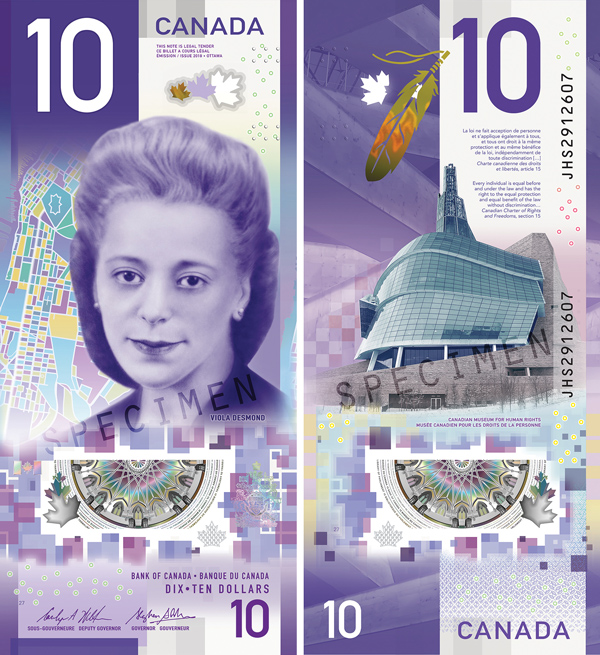Canada’s new $10 bill delivers a history lesson

A successful black businesswoman is jailed, convicted, and fined for refusing to leave a whites-only area of a movie theater in 1946. Local Baptist church leaders step in to lend assistance. An appeal proceeds through the court system, but ultimately proves unsuccessful. Sixty years on, a government apology and posthumous pardon attempt to right the wrong.
A page torn from a history book recording events from the southern United States? Not quite.
While reminiscent of incidents that occurred much farther south in the early part of the 20th century, the episode transpired in Nova Scotia, one of the maritime provinces on the east coast of Canada.
Viola Desmond and her court case became an inspiration for the pursuit of racial equality across Canada. A testament to an oft neglected but marked moment in Canadian history, her likeness now appears on Canada’s $10 banknote.
As Canada’s first vertical banknote, the new $10 bill features enhanced security features that are easy to check and difficult to counterfeit, including:
• a color-shifting eagle feather that changes from gold to green;
• raised ink on various parts of the bill; and
• detailed metallic images—the Library of Parliament’s vaulted dome ceiling, maple leaves, and Canada’s flag and coat of arms—in and around the large transparent window.
Exceptional process
In 2014, the Bank of Canada reviewed the processes used to select and design the visual content of its polymer banknotes. The result was a commitment by the bank to consult more openly and broadly within Canada on the development of the theme, subject matter, and images for new banknote series.
At the November 2018 launch of the new $10 note featuring Desmond, Bank of Canada Governor Stephen Poloz described the early stages of the new process: “Finance Minister Bill Morneau agreed with me that it was long past time to feature an iconic Canadian woman on the front of a regularly circulating banknote,” he said. “So the bank asked Canadians to tell us who that woman should be. And that invitation unleashed a flood of nominations—over 25,000 of them.”
The nominations resulted in a list of 461 qualified nominees. An independent advisory council whittled the roll down to 12, and a public opinion survey then asked Canadians to weigh in. Just under 90 percent of respondents had no objections to any of the 12 women. History experts helped the council produce a short list of five names, and focus groups then convened to offer ordinary Canadians’ opinions of the five women. The list met with approval and advanced to the bank, where the governor then consulted with the minister of finance. Per the Bank of Canada Act, the minister made the final decision.
“Banknotes are not only a secure means of payment that Canadians can use with confidence. They also tell the stories that have shaped our country,” said Poloz. “Now, each time this new vertical $10 bill changes hands, it will remind us of our continued pursuit of human rights and social justice in Canada.”
Time for change
When Desmond purchased her ticket at the movie theater that day in 1946, she received admission to the balcony—the seating generally reserved for nonwhite customers. But being nearsighted, and unaware of the policy, she went to sit in the floor section to be closer to the screen. A ticket taker noted her ticket was for upstairs seating, so she returned to the ticket counter to purchase a floor seat. Denied the purchase and realizing that her request was refused because of her race, she decided to sit on the main floor anyway. The police were called, and she was forcibly removed from the theater, injuring her hip, before she spent 12 hours in jail and paid the $20 fine.
While no laws existed in Nova Scotia to enforce segregation at the time, no court in the province had ruled on the legality of discriminatory policies in hotels, theaters, or restaurants. The tax on the balcony price of 20 cents was 2 cents; the tax on the floor price of 40 cents was 3 cents. In the end, Desmond was convicted of depriving the government of a penny in tax.
“In 1946, Viola Desmond took a courageous stand against injustice that helped inspire a movement for equality and social justice in Canada,” said Jennifer O’Connell, parliamentary secretary to the minister of finance, who spoke at the $10 banknote event. “More than 70 years later, we honor her as the first Canadian woman to appear on a [regularly circulating] banknote and hope her story inspires the next generation of Canadians to follow in her footsteps.”
Opinions expressed in articles and other materials are those of the authors; they do not necessarily reflect IMF policy.







